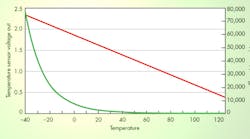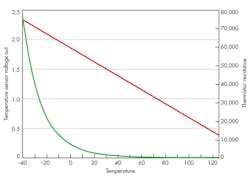To understand the concept of a remote temperature sensor and how it differs from a local temperature sensor, it’s best to first review some basics of temperature-sensor ICs. A silicon temperature-sensor IC takes advantage of the basic temperature-dependent behavior of silicon PN junctions.
Therefore, if you have two PN junctions of different areas and force a current through them, they produce two different forward voltage levels. With a constant current, the voltages rise or fall relative to the PN temperature junction. The difference between the voltages is proportional to absolute temperature:
Now that we understand the basic operating principle of all temperature-sensor ICs, the second issue concerns the differences between a remote temperature sensor and a local temperature sensor. A local temperature sensor’s PN junction is typically thermally connected to the ground pin of the package. Based on thermal equilibrium, the temperature experienced by the PN junction is essentially the same as that experienced by the printed-circuit board (PCB) where the ground pin is connected.
This file type includes high resolution graphics and schematics when applicable.
Remote temperature sensors sense the temperature locally like a local temperature sensor. In addition, they sense one or more remote diodes or transistors elsewhere in the system. In many cases, these remote elements are implemented in another IC, such as a processor, ASIC, or FPGA. The “remote diode” in this case is actually a PNP transistor with its collector tied to the device’s substrate.
This PNP is inherently available in most CMOS processes and, therefore, can be easily implemented in any complex, power-hungry circuit that may easily overheat. Alternatively, for a cost-effective system approach that must monitor multiple temperature points in a system, a standard transistor (such as a 2N3904 or 2N3906) could be utilized for each “remote” location.
Furthermore, a remote temperature sensor integrates an analog-to-digital converter (ADC) with an analog multiplexer on the ADC input to switch between the various temperature sources. This allows for direct interfacing to a controller via a standard serial interface, such as I2C or serial peripheral interface (SPI), as well as enables the offloading of some functionality to the temperature sensor for thermal management, such as over-temperature alerts.
Remote Junction Temperature Transistors
Remote temperature sensors are calibrated to work with a specific type of transistor connection. Since these remote transistors/diodes have varying characteristics based on process geometry and other process variables, the remote temperature sensor should incorporate methods to account for these variances when calculating the remote temperature. If a different type of connection is employed, then a “non-ideality” factor must be used to compensate for the different transistor type:
where:
TCF = temperature correction factor
TCR = center of the temperature range of interest
ηTS = remote temperature sensor non-ideality specification
ηProcess = non-ideality specification for remote transistor/diode
Many newer remote temperature sensors, such as Texas Instruments’ (TI) TMP451, have multiple options for non-ideality factor so that it can be used with various discrete transistors or process-node ASIC integrated temperature diodes.
Another common signal adjustment incorporated by remote temperature sensors is series-resistance cancellation. Series-resistance in an application circuit typically results from PCB trace resistance. This remote line length can be automatically cancelled by the remote temperature sensor, preventing what would otherwise result in a temperature offset. Typical devices cancel a total of up to 1 kΩ of series line resistance. This eliminates the need for additional characterization and temperature offset correction.
Once process geometries of the processors, ASICs, and FPGAs reached 90 nm and even smaller, it led to changes in the characteristics of the remote sensing diodes/transistors. Early generations of remote temperature sensors were operated by controlling the emitter current. At the smaller geometries, the physics of these transistors have changed such that VBE has become a function of collector versus emitter current. If the transistor’s BETA characteristic is independent of collector current, then controlling the emitter current provides adequate accuracy.
However, these new, smaller geometry transistors exhibit BETA characteristics that depend on the collector current. As such, many newer remote temperature sensors, such as TI’s TMP435, have implemented an automatic BETA compensation function by controlling the collector current rather than the emitter current. The TMP435 automatically detects and chooses the correct range based on the external transistor’s BETA factor.
Remote Temperature Junction or Thermistor?
Thermistors are the most commonly used temperature-measuring devices. A thermistor is essentially a resistive element whose resistance changes proportionally to the temperature experienced by the device. Since a thermistor is a relatively small-sized component, it can be placed very close to the object that it’s monitoring for temperature.
This could be a limiting factor for local temperature sensors in some applications. By substituting the remote transistor for the thermistor, you can achieve very similar footprints to that of a thermistor. However, you then get many of the benefits of using a temperature-sensor IC, including a lowering of the total power consumption, noise immune data transmission, and simplified implementation and signal processing.
Such a simplification is enabled by the linear response of a silicon temp sensor over a thermistor (see the figure). No additional processing is required to calculate the actual temperature.
Summary
Many industrial applications require monitoring the temperature in multiple locations within the system. Whether this temperature monitoring is to ensure system reliability or enable closed-loop control of a portion of the system, the ability to accurately monitor the temperature maximizes system performance.
This file type includes high resolution graphics and schematics when applicable.
Remote temperature sensors include all of the benefits of other IC temperature sensors, including linear response, no required calibration, and low power. They can monitor the temperature in multiple locations without requiring multiple signal processing paths. Depending on the chosen remote diode or transistor, sensors can be used in various mounting configurations that may otherwise be a struggle with a circuit-board-mounted local temperature-sensor IC.
References:





